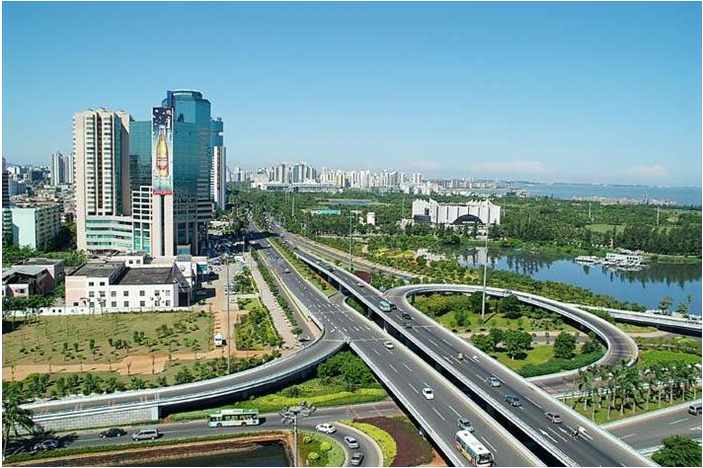(单词翻译:单击)

Science and technology.
科技。
Quieter traffic.
更安静的交通。
When the rubber hits the road.
当橡胶遇上公路。
Turning old tyres into new roads can help cut noise pollution.
把旧轮胎建成新式道路可以减少噪音污染。
AROUND one heart attack in 50 in rich European countries is caused by chronic exposure to loud traffic, according to the World Health Organisation (WHO). The ill-effects of noise pollution in such countries are second only to those from dirty air, says the WHO. Long-term exposure can cause hormonal imbalances as well as mental-health problems.
据世界卫生组织(WHO)报道,在欧洲发达国家中,平均每50个人就会有一个由于持续暴露在交通噪音中而患上心脏病。WHO还说,在这些国家,噪音污染产生的不良反应仅次于空气污染,长期暴露不仅会造成激素失调,还会引发精神问题。
Roadside barriers can help dampen the racket, but they are expensive-up to $600,000 per kilometre-and they often serve as magnets for graffiti. Besides, they work less well on windy days and are impractical along city streets. Happily, there is another option.
路边声屏障可以减少喧嚣,但它们太贵了——每公里高达60万美元,而且很容易变成乱涂乱画的场所,此外,它们在多风的时候效果并不好,更何况在城市街道边安装也不大现实。幸运的是,我们还有其他选择。
By adding rubber "crumbs", reclaimed from shredded tyres, to the bitumen and crushed stone used to make asphalt, engineers are designing quieter streets. First used experimentally in the 1960s, this rubberised, softer asphalt cuts traffic noise by around 25%. Even better, it also lasts longer than the normal sort.
在沥青和碎石里添加从轮胎碎片中回收的废胶末,再铺成柏油路,这样工程师可以设计出更加安静的街道。第一条试验性道路出现在20世纪60年代,这种加入橡胶而变得更柔软的柏油路可以减少约25%的噪音,更棒的是它的寿命比普通路面更加持久。
Not surprisingly, rubberised asphalt is catching on. Enough tyres are recycled in America each year to produce 20,000 lane-miles (32,000 lane-kilometres) of the stuff, enough to re-pave about 0.5% of America's roads, according to Liberty Tyre Recycling, a Pittsburgh firm that handles around a third of America's recycled tyres. Rubber roads are also popular in China, Brazil, Spain and Germany. Their popularity could spread further, since it is now possible to make rubberised asphalt less expensively than the traditional sort.
参入橡胶的柏油路渐渐变得流行起来,这并不奇怪,根据自由轮胎回收公司(位于匹兹堡,掌控着美国约1/3的轮胎回收业务)的说法,美国每年回收的轮胎足够修建2万英里(3.2万公里)的橡胶柏油路,足够重新铺设美国0.5%的公路。在中国、巴西、西班牙和德国,这种橡胶路同样非常流行,由于现在可以把橡胶柏油路的成本控制得比传统路面还低,所以这种趋势会越来越流行。
That is because rubber can partially replace bitumen, the binding agent used to hold the crushed stones together in ordinary asphalt. Bitumen is derived from oil, which means its price has risen over the past decade alongside that of crude oil. Discarded tyres, by contrast, are cheap and are likely to get cheaper. In rich countries, around one tyre is thrown away per person per year. They are piling up especially quickly in Europe, where dumping them into landfills was banned in 2006.
由于橡胶会部分替代沥青,在传统柏油里面,沥青这种粘合剂的作用是把碎石裹在一起,而沥青源于石油,这意味着过去十年其价格随着原油价格的上涨而增加,相比之下,那些废弃的轮胎不仅便宜,而且会变得越来越便宜。在发达国家,平均每人每年都要扔掉一个轮胎,轮胎的累积在欧洲特别迅速,因为2006年欧洲禁止把它们倒入垃圾堆。
Rubberised asphalt keeps the noise down in a couple of ways. Pores between the stones in standard asphalt must be small, because if the gaps are too big the bitumen binding cannot do its job properly. Adding rubber thickens the bitumen. That allows bigger pores, which help to trap and disperse sound waves. The rubberised bitumen itself is flexible and slightly springy, which enables it to absorb more unwanted sonic energy.
橡胶柏油能减小噪音的两个原因如下:在标准柏油里,碎石之间的气孔必须很小,如果缝隙太大,沥青就不能正常约束碎石,橡胶的加入可以使沥青变厚,允许更大的气孔存在,这样就有助于捕获和分散声波;而参入了橡胶的沥青本身也具有柔韧性和轻微的弹性,这可以使它吸收更多讨厌的音波能量。
Shredded tyres are not the last word in exotic road toppings. A substance called PERS, or poro-elastic road surfacing, is being developed with a mix of private and public money in the European Union. It is made from a blend of crushed rock, rubber and polyurethane, a synthetic plastic that replaces bitumen as the binding agent and allows even bigger pores in the road surface. PERS is not cheap, costing around five times as much as rubberised asphalt. But you get what you pay for: tests suggest it can cut road noise in half. In some particularly noisy areas, reckons Luc Goubert, who is co-ordinating the PERS project at the Belgian Road Research Centre in Brussels, the resulting boost to property values-and, therefore, land taxes-could help cover the cost.
轮胎碎片并不是最新式的道路添加物,欧盟依靠公共资金和私人资金开发了一种叫PERS东西(或者称之为多孔塑胶路面),它由碎石、橡胶和聚氨酯制成,人造塑胶聚氨酯可以代替沥青,因为这种粘合剂可以允许更大的气孔存在于路面。PERS并不便宜,其成本几乎是橡胶柏油的5倍,但这完全物有所值,据Luc Goubert(布鲁塞尔比利时路研究中心员工,负责协调PERS工程)测算,在一些特别吵闹的地方可以减少一半的噪音。这个结果也推动了周边的房产价格——所以地税或许可以帮助抵消掉成本。


